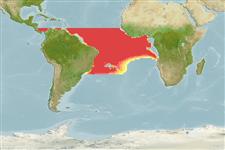Actinopterygii (ray-finned fishes) >
Stomiiformes (Lightfishes and dragonfishes) >
Stomiidae (Barbeled dragonfishes) > Melanostomiinae
Etymology: Eustomias: Greek, eu = good + Greek, stoma = mouth (Ref. 45335).
Environment / Climate / Range
Ecology
Marine; pelagic-oceanic. Tropical, preferred ?; 12°N - 25°S
Eastern Atlantic: two records at 5°N 20°W and 11°S 11°W. Western Atlantic: Gulf of Mexico, Bahamas, and the western Atlantic from 12°N to 23°S.
Size / Weight / Age
Maturity: Lm ? range ? - ? cm
Max length : 25.3 cm SL male/unsexed; (Ref. 4468); 17.9 cm SL (female)
Short description
Morphology | Morphometrics
Dorsal
soft rays
(total): 21-25;
Anal
soft rays: 35 - 42. Body black, elongate and slender; depth 5-8% SL. Long, tapering protrusible snout. Slender barbel stem and two terminal bulbs. Barbel stem has little or no external pigment (Ref. 37039). Two terminal bulbs separated by a short interspace, less than half to 1.5 the length of distal bulb. Barbel length increasing to 70-91% SL in specimens 10.5-15 cm, apparently decreasing in large females (17.9-25.3 cm) to 46-51%. Terminal filament short (9% SL or less, slightly longer to 5 times longer than distal bulb) with 2 well-developed side branches arising just distal to bulb and often other branches along its length. All branches with prominent internal bulblets, some nearly the same diameter as branch, resulting in a series of swellings in many specimens. No melanophores in stem, between bulbs, or in filaments in specimens up to 15 cm SL; none between bulbs at any size. Middorsal paired spots under skin between occiput and dorsal-fin origin usually 8, sometimes 7 (Ref. 11333).
Feeds on midwater fishes (Ref. 37039).
Life cycle and mating behavior
Maturity | Reproduction | Spawning | Eggs | Fecundity | Larvae
Gibbs, R.H. and M.A. Barnett, 1990. Melanostomiidae. p. 308-337. In J.C. Quero, J.C. Hureau, C. Karrer, A. Post and L. Saldanha (eds.) Check-list of the fishes of the eastern tropical Atlantic (CLOFETA). JNICT, Lisbon; SEI, Paris; and UNESCO, Paris. Vol. 1. (Ref. 4468)
IUCN Red List Status (Ref. 115185)
CITES (Ref. 94142)
Not Evaluated
Threat to humans
Harmless
Human uses
More information
Common namesSynonymsMetabolismPredatorsEcotoxicologyReproductionMaturitySpawningFecundityEggsEgg development
Age/SizeGrowthLength-weightLength-lengthLength-frequenciesMorphometricsMorphologyLarvaeLarval dynamicsRecruitmentAbundance
ReferencesAquacultureAquaculture profileStrainsGeneticsAllele frequenciesHeritabilityDiseasesProcessingMass conversion
Tools
Special reports
Download XML
Internet sources
